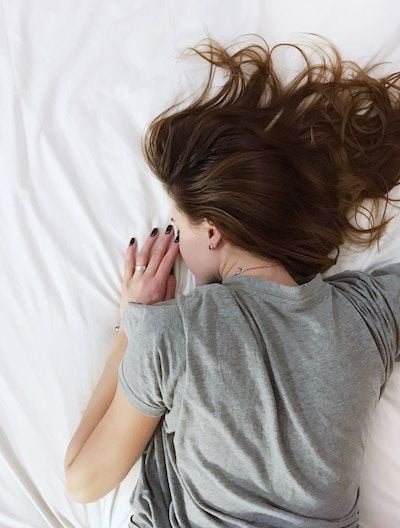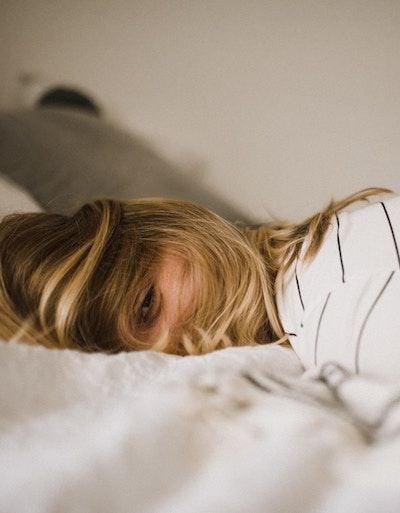![]() Written by Martin Reed, MEd, CHES®, CCSH.
Written by Martin Reed, MEd, CHES®, CCSH. ![]() Reviewed by .
Reviewed by .
What is sleep restriction?
 Sleep restriction therapy is one of the main techniques used in a course of cognitive behavioral therapy for insomnia (CBT-I).
Sleep restriction therapy is one of the main techniques used in a course of cognitive behavioral therapy for insomnia (CBT-I).
At its core, sleep restriction is all about reducing the amount of time spent in bed to more closely match the amount of time spent sleeping.
When I work with clients, many of them begin to worry whenever sleep restriction is mentioned. That is because they think that sleep restriction means they will get less sleep.
However, sleep restriction involves allotting an amount of time for sleep that is at least as long as your average nightly sleep duration.
If, for example, you average 5.5 hours of sleep, you might want to add about 30 minutes onto that and try spending no more than 6 hours in bed.
When sleep restriction is followed this way, it shouldn’t lead to less sleep because the amount of time spent in bed is always more than the amount of time spent asleep.
If you spend less than 4.5 hours asleep at night, I would suggest allotting no less than 5 hours for sleep.
That’s because we don’t want to end up depriving ourselves of the opportunity to sleep — and our aim isn’t to create high levels of daytime sleepiness that might increase the risk of accidents.
How does sleep restriction work?
 Sleep restriction therapy for insomnia is evidence-based. This means that clinical studies have confirmed that the technique works.
Sleep restriction therapy for insomnia is evidence-based. This means that clinical studies have confirmed that the technique works.
Sleep restriction works because it targets behaviors that insomniacs do (often without even knowing it) that harm sleep.
Many people with insomnia spend too much time in bed. The reason for this? They believe that spending more time in bed will mean they will get more sleep.
Spending more time in bed does not mean spending more time asleep.
When we spend more time in bed than we should, we actually spend more time tossing and turning during the night. We worry about being unable to sleep. We get frustrated that we can’t fall back to sleep after waking during the night. We think about the fact our alarm is about to go off.
When we spend too much time in bed, all we are doing is giving ourselves more time to be awake and worrying about sleep. As soon as we start to worry about sleep, we can engage in a struggle that makes it harder to sleep. The harder it is to sleep, the more we worry about sleep. This starts a vicious cycle of more worry, more struggle, and less sleep.
By reducing the amount of time we spend in bed to more closely match the amount of time we spend asleep, we are giving ourselves less time to spend lying awake in bed. This means less time spent feeling worried, anxious, and frustrated — and less time spent struggling.
Following sleep restriction also helps us link the bed and the bedroom with sleep rather than wakefulness — an important part of stimulus control therapy for insomnia.
How much time should you spend in bed?
You can use the tool below to help you figure out how much time you should be spending in bed. When filling out the form below, think about your sleep over the past week.
Stick to a regular sleep window.
 Now you know how much time you should be spending in bed.
Now you know how much time you should be spending in bed.
Think of this as your ‘sleep window’.
Your sleep window will be your normal sleep schedule moving forward.
To figure out your sleep window, it is usually easiest to work out when you want or need to be out of bed in the morning. When you have this time, take away the amount of time you should be spending in bed and you now have your ‘lights out’ time.
Your ‘lights out’ time is the start of your sleep window.
The start of your sleep window is the earliest time you can go to bed. It is important that you do not go to bed before your sleep window begins, no matter how sleepy you feel.
If your sleep window begins and you don’t feel sleepy and ready for bed, don’t go to bed yet. Wait until you do feel sleepy, then go to bed.
However, no matter what time you go to bed or how little sleep you get during the night, it is important that you are out of bed by the end of your sleep window, every single day, no matter what.
Changing the amount of time spent in bed.
 You want to follow your sleep window for at least 1 week before making any changes.
You want to follow your sleep window for at least 1 week before making any changes.
Any changes to your sleep window should be based on your sleep efficiency. This is a percentage and reports the amount of time you spend in bed sleeping.
For example, if your sleep efficiency is 50% it means that only half of the time you spend in bed is spent sleeping. If your sleep efficiency is 80% it means that 80% of the time you spend in bed is spent sleeping.
After following your sleep window for a week, calculate your sleep efficiency. If your sleep efficiency is less than 85%, reduce your sleep window by 15 minutes (but do not reduce your sleep window to less than 5 hours) and reassess in 1 week.
If your sleep efficiency is 85% or higher, add 15 minutes to your sleep window. You can do this by starting your sleep window 15 minutes earlier or ending it 15 minutes later.
It can be hard to figure out your sleep efficiency. Below is a tool that will help you. When filling out the form below, think about your sleep over the past week.
What are the effects of sleep restriction?
 If you follow sleep restriction in the right way, you will notice that more of the time you spend in bed is spent asleep rather than awake.
If you follow sleep restriction in the right way, you will notice that more of the time you spend in bed is spent asleep rather than awake.
To get to that point, it is important that you follow an appropriate sleep schedule, do not go to bed before you feel sleepy, and always get out of bed at the same time every day.
These actions will strengthen your sleep system, and you will be able to increase the amount of time you spend in bed as your sleep improves.
In the short-term, you might find it hard to stay awake until the start of your new sleep schedule. However, it is important to avoid going to bed until your sleep window begins. This will help build sleep pressure and make it easier for you to fall asleep.
In my experience, many people notice improvements within a few weeks of following sleep restriction.
Sleep restriction summary.
 Sleep restriction is a core part of cognitive behavioral therapy for insomnia (CBT-I).
Sleep restriction is a core part of cognitive behavioral therapy for insomnia (CBT-I).
It is evidence-based, which means it has been clinically proven to be effective.
Sleep restriction means reducing the amount of time you spend in bed to more closely match the amount of time you spend asleep.
Sleep restriction will lead to sleep consolidation (better sleep efficiency).
The amount of time you allot for sleep can be increased over time, as your sleep improves.
If you enroll in my insomnia coaching course you will learn how to create an approachable and realistic sleep window that doesn’t require quite so much ongoing monitoring or calculations! Since you’re a human being, we will take a far more human approach that will also help you shift attention away from sleep and toward living the kind of life you want to live.
Please rate this page
Share this page
Are you ready?
 If you enroll in my insomnia coaching course you will rediscover what it feels like to live a life independently of sleep.
If you enroll in my insomnia coaching course you will rediscover what it feels like to live a life independently of sleep.
You will move away from struggling with insomnia and all the difficult thoughts and feelings that often come with it.
Are you ready to move away from the endless and exhausting struggle?
Are you ready to get your life back from insomnia?
Not ready for the Insomnia Coach course just yet?
Get my free sleep training for insomnia course.
- Get 1 email every day for 2 weeks.
- Learn how to improve your sleep.
- Pay nothing (it’s free).
Over 10,000 people have taken the course and 98% would recommend it to a friend. Your email address will not be shared or sold. You can unsubscribe at any time. Privacy policy.



